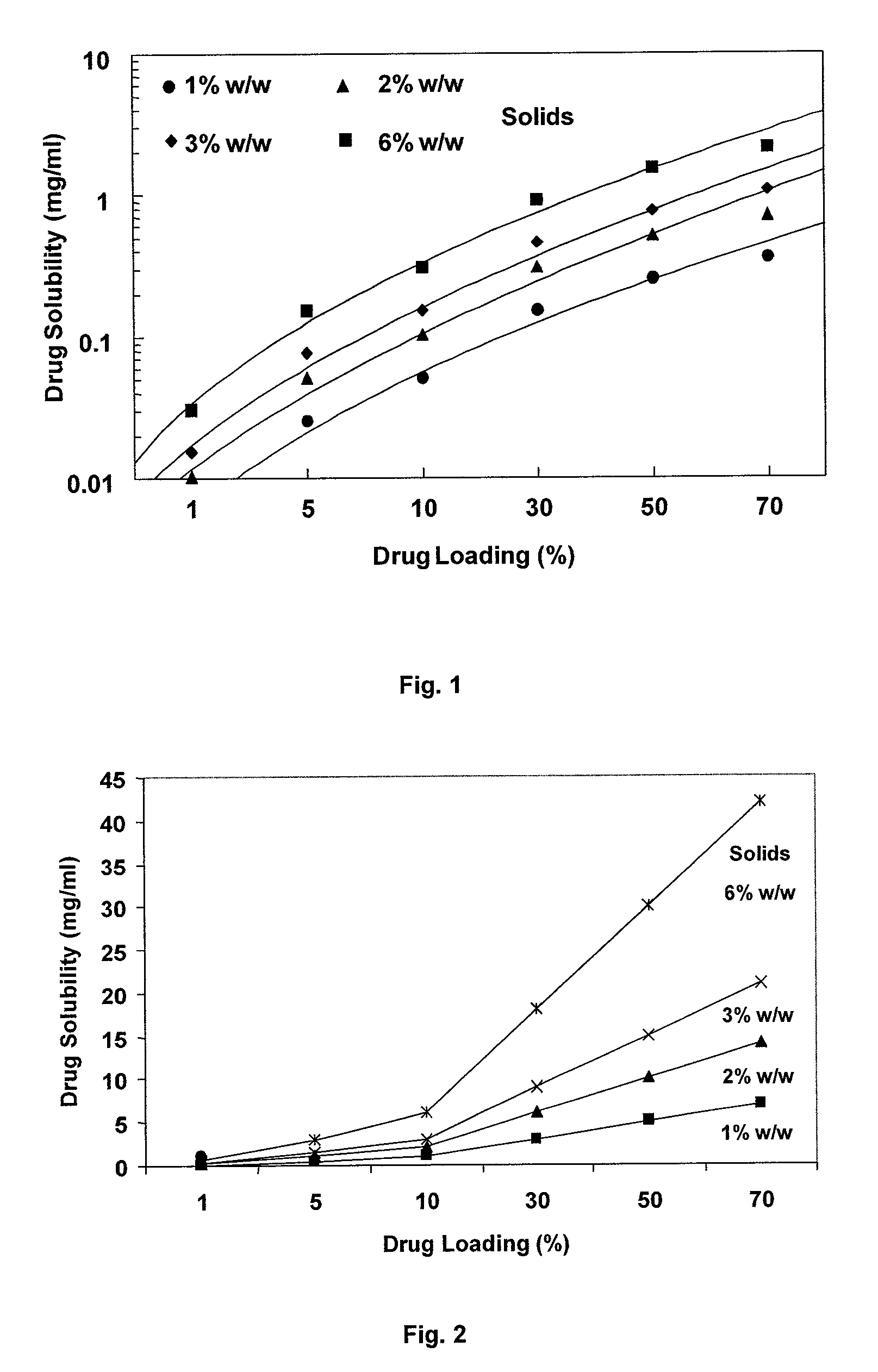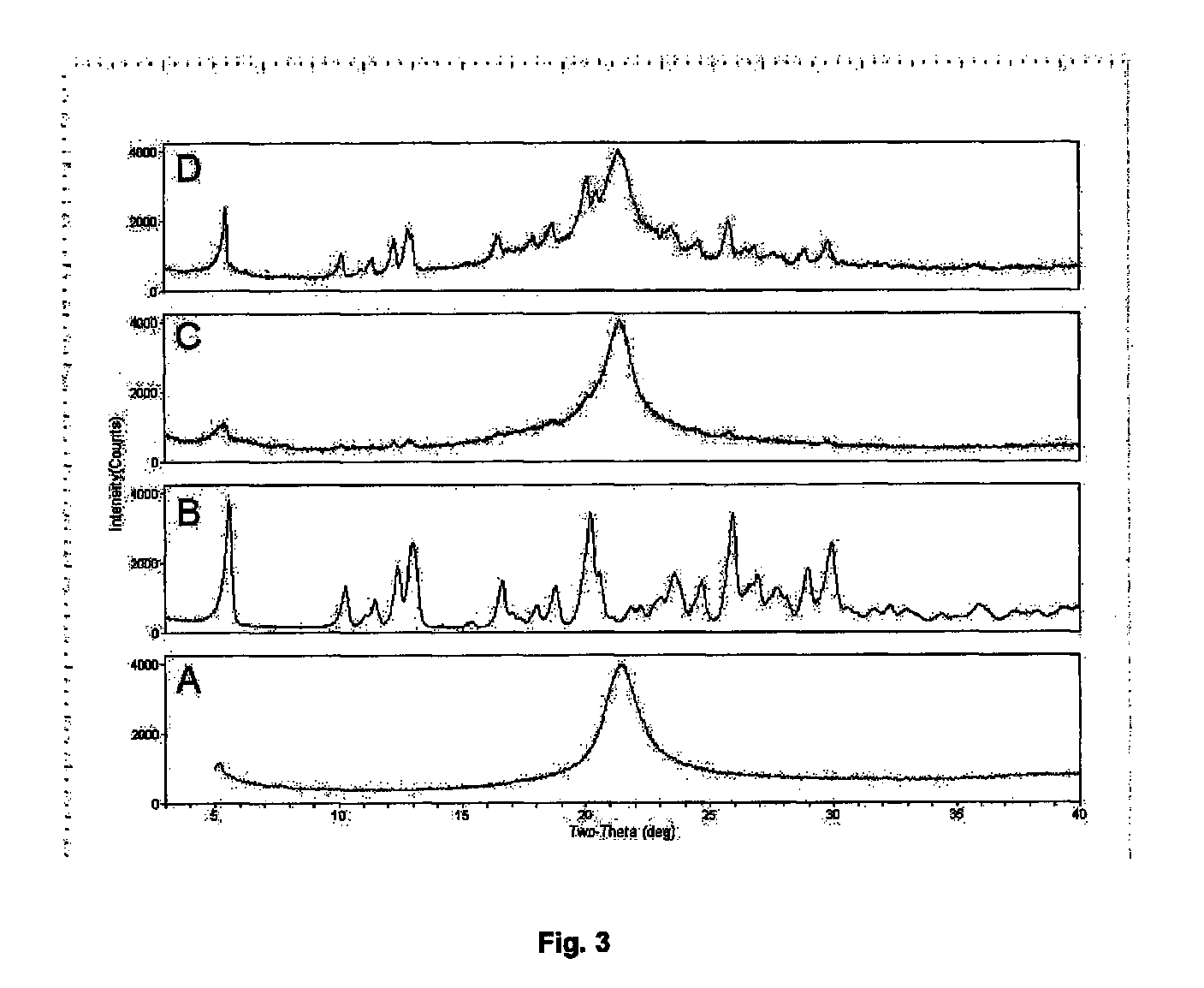Dry powder formulations of particles that contain two or more active ingredients for treating obstructive or inflammatory airways diseases
a technology of active ingredients and powder formulations, applied in the field of organic compounds, can solve the problems of difficult prediction of adhesive forces between drug crystals and carriers, poor powder flow, fluidization and dispersion properties, etc., and achieve the effects of improving physical and chemical stability, reducing stability, and reducing interparticle cohesive forces
- Summary
- Abstract
- Description
- Claims
- Application Information
AI Technical Summary
Benefits of technology
Problems solved by technology
Method used
Image
Examples
example 1
Preparation of a Dry Powder Formulation Comprising Spray-Dried Particles that Contain Formoterol and Budesonide
[0157]A dry powder formulation comprising spray-dried particles that contain formoterol fumarate and budesonide were prepared by a two-step manufacturing process.
[0158]In the first step, 1.38 g of distearoylphosphatidylcholine (DSPC) (Genzyme Pharmaceuticals, Cambridge, Mass., USA), and 119.6 mg calcium chloride (J T Baker) were dispersed in 164 g of hot deionised water (T=70° C.) using an ULTRA-TURRAX™ high shear mixer (model T-25) at 10,000 rpm for about 1 minute. The resulting DSPC / CaCl2 dispersion was then cooled in an ice bath. 98 mg of micronised formoterol fumarate (Industriele Chimica s.r.i, Italy) was added while mixing. The formoterol has a water solubility of about 1 mg / ml, and as such, dissolves in the aqueous phase. The resulting formoterol / DSPC / CaCl2 dispersion was then passed through a high pressure homogenizer (AVESTIN EMULSIFLEX-C5™ high pressure homogenize...
example 2
Preparation of Dry Powder Formulations Comprising Spray-Dried Particles that Contain Fixed Dose Combinations of Micronised Indacaterol Maleate Crystals Coated with Amorphous Glycopyrrolate and Phospholipid
[0162]In this Example inhalable dry powders comprising indacaterol maleate, glycopyrrolate, and excipients (distearoylphosphatidylcholine (DSPC), calcium chloride, and trehalose) were manufactured by spray drying an emulsion-based feedstock.
[0163]The feedstock was prepared by mixing an individually prepared vehicle emulsion and a drug annex solution.
[0164]The vehicle emulsion was prepared by emulsifying perfluorooctyl bromide (PFOB, perflubron) in an aqueous dispersion of DSPC containing dissolved CaCl2. A two-step process was employed in which a coarse emulsion was prepared with a ULTRA-TURRAX™ high shear mixer, followed by homogenization through an AVESTIN C50™ homogenizer. The resultant vehicle emulsion was a stable oil-in-water emulsion with a median emulsion droplet size in th...
example 3
Physicochemical Properties of a Dry Powder Formulation Comprising Spray-Dried Particles that Contain Fixed Dose Combinations of Indacaterol Maleate and Glycopyrrolate
[0171]In this Example the physicochemical properties (e.g. morphology, primary particle size) of the powders prepared according to Example 2 were measured.
[0172]Scanning electron microscopy (SEM) was used to qualitatively assess the morphology of the spray-dried particles. Samples were mounted on silicon wafers that were then mounted on top of double-sided carbon tape on an aluminium SEM stub. The mounted powders were then sputter-coated with gold:palladium in a DENTON™ sputter-coater for 60 to 90 seconds at 75 mTorr and 42 mA, producing a coating thickness of about 150 Å. Images were taken with a PHILIPS™ XL30 ESEM™ scanning electron microscope operated in high vacuum mode using an Everhart-Thornley detector to capture secondary electrons for the image composition. The accelerating voltage was set at 20 kV using a LaB6...
PUM
| Property | Measurement | Unit |
|---|---|---|
| mass median aerodynamic diameter | aaaaa | aaaaa |
| mass median aerodynamic diameter | aaaaa | aaaaa |
| mass median aerodynamic diameter | aaaaa | aaaaa |
Abstract
Description
Claims
Application Information
 Login to View More
Login to View More - R&D
- Intellectual Property
- Life Sciences
- Materials
- Tech Scout
- Unparalleled Data Quality
- Higher Quality Content
- 60% Fewer Hallucinations
Browse by: Latest US Patents, China's latest patents, Technical Efficacy Thesaurus, Application Domain, Technology Topic, Popular Technical Reports.
© 2025 PatSnap. All rights reserved.Legal|Privacy policy|Modern Slavery Act Transparency Statement|Sitemap|About US| Contact US: help@patsnap.com



